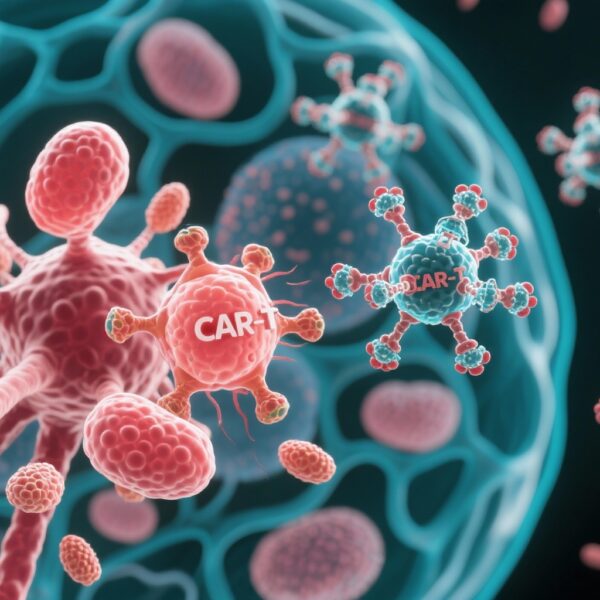Introduction
Peripheral T-cell lymphomas (PTCL) are a heterogeneous group of aggressive non-Hodgkin lymphomas with historically poor outcomes. First-line treatment regimens often include CHOP or CHOP-like chemotherapies; however, progression-free survival (PFS) rates remain suboptimal, ranging historically from 13% to 36% at five years. Efforts to improve outcomes include combining novel agents with frontline chemotherapy and consolidating remission with autologous hematopoietic stem-cell transplantation (AHCT). While AHCT prolongs remission for patients responding to initial therapy, relapses remain common, underscoring the need for strategies to sustain durable remissions.
Romidepsin, a histone deacetylase inhibitor, is FDA-approved for relapsed/refractory PTCL based on response rates approximating 25%. Although its addition to frontline CHOP (Ro-CHOP) did not yield improved PFS in a large randomized trial, certain PTCL phenotypes (notably T follicular helper subtype) might derive benefit. Maintenance therapy post-AHCT, successfully employed in other lymphomas, was hypothesized to improve PFS in PTCL by suppressing residual disease.
This multicenter phase 2 study (NCT01908777) evaluated the efficacy and safety of maintenance romidepsin following AHCT in PTCL patients to address the unmet need of relapse prevention after transplantation.
Study Design and Methods
This was a single-arm, multicenter phase 2 clinical trial enrolling adult patients with PTCL who underwent AHCT in first complete remission (CR1) or first partial remission (PR1) designated as cohort 1 (n=26). An exploratory cohort (cohort 2, n=7) included patients transplanted in second remission or with high-risk histologies.
Patients underwent AHCT conditioned with carmustine, etoposide, cytarabine, and melphalan. Romidepsin maintenance commenced between 42 and 80 days post-transplant at 14 mg/m² intravenously, initially every two weeks until six months, then every three weeks up to one year, and every four weeks until two years post-transplant. Dose adjustments were guided by toxicity.
Primary endpoint was 2-year PFS in cohort 1. Secondary endpoints included overall survival (OS), PFS in the exploratory cohort, and safety. Response assessments utilized PET scans following Revised Response Criteria for Malignant Lymphoma. Kaplan-Meier analysis estimated survival outcomes.
Key Findings
Forty-seven patients consented; 13 did not receive romidepsin due to relapse before treatment initiation, cardiac contraindications, treatment refusal, or diagnostic reclassification. The most common histology was angioimmunoblastic T-cell lymphoma (AITL).
After a median progression-free follow-up of 32 months, 15 of the 25 evaluable patients in cohort 1 were progression-free at two years. The estimated 2-year PFS post-transplant was 62% (95% confidence interval [CI], 45–83%). Median PFS was not reached but estimated at 36 months with extended follow-up. OS at two years for all patients was 79% (95% CI, 66–94%).
In cohort 2, 2-year PFS was lower at 43% (95% CI, 18–100%), consistent with higher-risk status. An exploratory analysis of 11 AITL patients revealed 2-year PFS of 55%.

Maintenance romidepsin was feasible and generally well-tolerated. Common adverse events (all grades) included nausea (68%), fatigue (65%), anemia (47%), thrombocytopenia (48%), and neutropenia (44%). Grade 3/4 neutropenia occurred in 24%, and lymphopenia in 21%. Few patients required dose reductions or discontinued due to toxicity. Serious adverse events were infrequent, including one patient with cytomegalovirus retinitis.
Expert Commentary
Despite not meeting the predefined primary efficacy goal of 70% 2-year PFS, the observed 62% rate suggests a potential clinical benefit compared to historical controls demonstrating 36%–44% 2-year PFS after AHCT alone. The absence of a randomized control limits definitive efficacy conclusions, underscoring the need for larger or comparative trials.
Notably, 28% of consented patients never initiated maintenance due to early post-transplant progression or other issues, highlighting that a subset remains at high risk where alternative or intensified consolidation strategies are necessary.
The tolerability profile of romidepsin maintenance was acceptable, with manageable hematologic toxicities consistent with prior experience. Quality of life (QoL) impacts from frequently reported symptoms such as nausea and fatigue warrant evaluation in future studies with patient-reported outcomes.
Molecular heterogeneity in PTCL suggests that maintenance approaches might achieve greater efficacy when tailored to histologic or molecular subtypes. Retrospective data have implicated better romidepsin response in T follicular helper (Tfh) phenotypes. Ongoing trials exploring brentuximab vedotin and immune checkpoint inhibitors as maintenance also point toward biomarker-guided consolidation.
Conclusion
Maintenance therapy with romidepsin after AHCT in PTCL is feasible and demonstrates encouraging PFS with acceptable toxicity. This study provides foundational data supporting the concept of post-transplant maintenance in PTCL; however, larger, randomized trials with stratification by PTCL subtypes and inclusion of QoL endpoints are needed to confirm clinical benefit and define optimal patient selection.
Future research should focus on integrating biomarker-driven maintenance strategies and combination approaches to improve long-term outcomes after AHCT in this high-risk patient population.
References
Khan N, Dahi PB, Khimani F, Shustov AR, Shadman M, Ruan J, Moskowitz AJ, Zelenetz AD, Noy A, Straus DJ, Drullinsky P, Hamilton A, Kumar A, Sauter CS, Shah GL, Matasar MJ, Drill E, Davey T, Hancock H, Ganesan N, Galasso N, van Beisen K, Giralt S, Horwitz SM. Maintenance therapy with romidepsin after autologous stem-cell transplant for peripheral T-cell lymphoma. Blood Adv. 2025 Sep 23;9(18):4687-4692. doi: 10.1182/bloodadvances.2024014263 IF: 7.1 Q1 . PMID: 40179392 IF: 7.1 Q1 .


